|
Steward
Community Woodland, Devon
Community
introduction by Daniel Thompson-Mills, written for the book publication
'Settlements' in February 2015, with additional planning update by David
Spero, June 2019.
'Settlements' by David Spero, is an ongoing
photographic record of a small number of communities and individuals in
Britain, who are building, and exploring alternative land-based, low
impact ways of living. The exhibition at Kestle Barton included
photographs taken after 2015 at Steward Community Woodland. The
community, after fifteen years of temporary planning permission, had
applied for permanent permission in 2015. This was refused along with a
subsequent appeal and an application for a Judicial Review. By the time
the injunction compliance date passed in April 2019, all eight
households had left the woods and all homes and other non-agricultural
structures had been dismantled and removed.
Community Introduction
Steward Community Woodland is
a low impact settlement comprising a group of people living and working
together in a 32-acre former conifer plantation on the edge of Dartmoor.
We are committed to fostering environmental awareness and providing
innovative sustainable solutions and examples of sustainable land use.
Since 2000, we have been exploring and experimenting with permaculture
techniques for land use and food growing, community organisation and
dynamics, renewable energy and appropriate technology, small-scale
woodland management, and experiential and home education. We have built
and maintained our own experimental low impact dwellings using timber
from the woodland and reused materials.
Our community is based on the ethics of friendship, co-operation, earth
care and people care, and on using resources for need, not greed. We
value open, honest communication, wisdom and group cohesion; we enjoy
sharing our skills and knowledge, and value learning from others.
Since becoming resident on the land on ‘Earth Day’ in April 2000, we
have been granted two five-year periods of temporary planning
permission, first in 2002 and then again in 2009.These were both
hard-won on appeal after public inquiries. We are currently in the
process of applying for permanent permission.
From the initial community of 10 adults, we are currently 13 adults, 7
children and 2 teenagers, and one long-term volunteer, along with dogs,
chickens, sheep and goats. Meanwhile, wildlife is all around us. We
share this wood with the wood ants, plants, ravens, owls and tits, the
spiders, bats, mice, fungi, lichens… ad infinitum. We are a humble, yet
important and integral, part of the web of life.
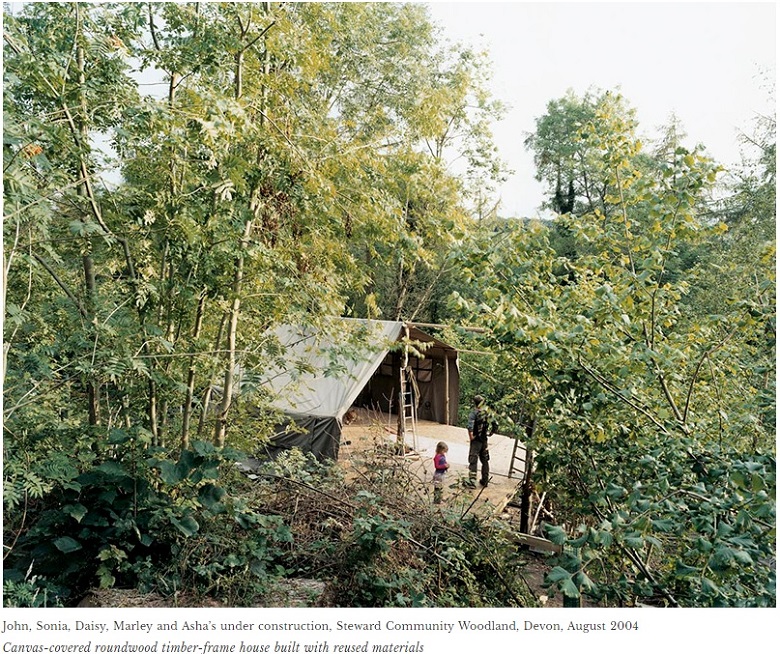
Having lived under wood and
canvas for over 15 years, we are a prime example of ‘low impact’ living.
We prefer the term ‘positive impact’ because, rather than having a low
adverse environmental impact, we are finding our way back to our place
in the forest – the place we left as hunter-gatherers, then semi-nomadic
pastoralists, hundreds or thousands of years ago. In other words, humans
have lived in community on the land for the vast majority of their time
on this planet as an integral part of a healthy, functioning ecosystem,
with a positive impact on biodiversity.
Here at Steward Wood we are working to combine these ancient ways of
living with modern technologies (solar panels, computers, the web etc.)
and innovative ways of thinking and organising (permaculture, sociocracy,
rewilding etc). This is all within the context of the huge environmental
challenges we as humans face on this beautiful earth today. In contrast
to how as a species we have abused and degraded this paradise, and
increasingly still do so, our role on this planet should be as guardians
and stewards for all of life.
Coming out of the 1990s'
activist scene, we were young, energised, enthusiastic and inspired by
permaculture: wanting not just to rail against what we felt was wrong
with the world, but to create a positive alternative. We wanted to be
living on the land, researching and experimenting with sustainable ways
of living, with the aim of inspiring others. Those were heady days, and
over the years we have matured, responded and adapted. After six years
of only using crosscut saws and axes to fell and process trees for
firewood and building materials (an achievement of which we are very
proud), we made the practical and realistic decision to start using
petrol chainsaws, freeing up our time and energy enormously for other
things. We still, however, fell and coppice most trees using hand tools
– combining the old ways with the new and finding the right balance. We
were also, for the first six years, a vegan community, but we eventually
adapted to our changing needs and perspectives on life. It’s now left to
the individual to choose what they wish to eat, and we make sure that at
communal meals everyone’s diet is catered for.

Despite using fossil fuels, we are working to reduce our dependency on
them by exploring alternatives. To this end, we generate all our
electricity from a micro-hydro scheme (making use of the streams running
down the hill) and from solar panels.
The Art of Community
Rediscovering the art of community, of co-operation and sharing, is the
foundation of how we go forward as humanity. It is only by living
together in harmony that we can find and implement solutions to the
environ-mental challenges of our times. This is a journey from a
competitive, individualistic, materialistic and youth-centred dominant
culture to a rediscovery and embodiment of the ideals of love,
co-operation, sharing and mutual respect. It is finding the right
balance between total communal living and the nuclear family. To this
end, each family and household at Steward Wood has its separate dwelling
and family life, while we share communal facilities and come together
often to discuss, work, eat and play. We share our skills, while valuing
our unique talents and gifts – we are both empowered individual
dependent on each other – in short, the community is greater than the
sum of its parts.
Another important aspect of intentional community is having a
communality of purpose and ethics, and a commitment to working with
others towards achieving that purpose (which can adapt and change over
time, as we’ve seen), while accepting and celebrating diversity. Again,
we feel we have found the right balance for us, and it is for this
reason, along with the love we feel for each other, that we are
thriving.
Organisation and Governance
The land is owned by a Workers Co-operative, of which all residents are
members. We are a non-hierarchical group and, having used consensus
decision-making for many years, in recent times we have moved over to
the sociocracy model of organisation and decision-making, which is
working well for us. Sociocracy is a consent-based approach aimed at
inclusive decision- making, efficient governance and the ongoing
evaluation of our project. Objections and ‘arguments’ (reasonable,
logical reasons given to support or object to a proposal) are welcomed
as gifts that test the integrity of ideas and enrich the creative
process. The principle of consent allows for ‘good enough’ measures to
keep the creative process moving, along with the peace of mind that
comes when everyone has the power to influence change when it becomes
necessary and beneficial to do so. From time to time, those who wish to
do so form a Listening Circle to share their feelings, listen to others,
and work through any challenges or difficulties that have arisen in the
group.
Where there is capacity for new members then any suitable applicants
undergo a trial period of at least three months, with frequent feedback
sessions to monitor how they are progressing. We have been a stable
group for many years now, with very little coming and going of members.
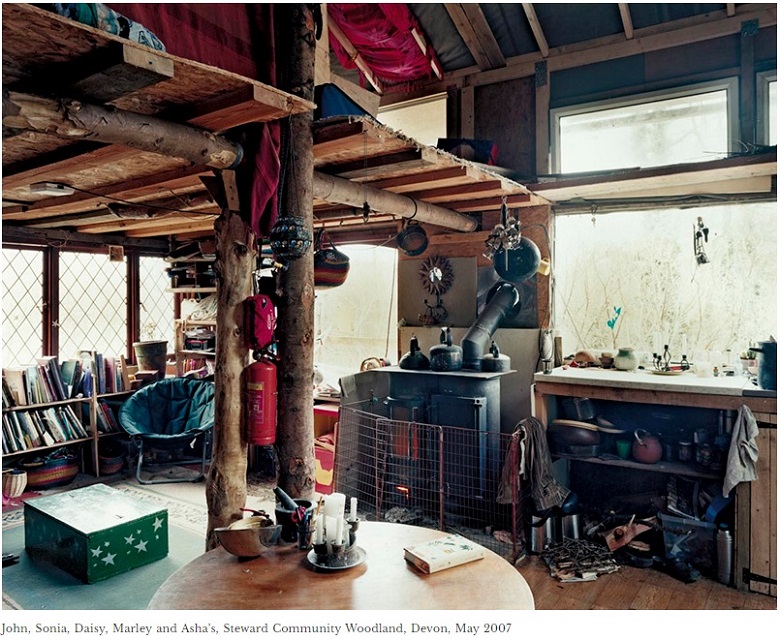
Subsistence Living and Livelihoods
Although we generate financial income from our activities on and
off-site, the most important factor in our sustainable livelihoods is
the subsistence element. In other words, rather than maximising income
and profits from our business activities, we provide most of our own
material needs from the land ourselves, thus reducing the need to earn
large sums of money. Subsistence is a significant and bonding element of
our community and ethos – and it allays very significant costs
(financial and environmental that would otherwise be incurred if we
lived elsewhere.
The subsistence goods and services we provide for ourselves include:
water, wood for fuel, wood as building material, food, electricity
generated through renewable sources, sanitation and composting (organic
waste recycling), shelter, homemade furniture, clothing, toys etc.,
social goods such as shared childcare and shared transport, holistic
health care, including herbal medicine, maintenance of the low impact
structures and infrastructure by ourselves or volunteers (rather than
employing plumbers, electricians, builders etc.), entertainment and
music.
The majority of our time is
spent working on-site to meet these needs. Day-to-day tasks include:
child care and education, firewood processing, woodland management,
human and organic waste disposal, structure maintenance, wildlife
monitoring, garden maintenance, food production, community dynamics,
peer counselling, recycling schemes, laundry and making herbal
medicines. These activities are an integral part of our day-to-day life,
and are a vital part of what we have to offer in demonstrating a
sustainable way of life.
Financial income is generated from commercial on-site activities, by
running courses, and by making and selling timber, value-added timber
products, tools and herbal preparations. Our courses include Healing
Hedgerow, Bushcraft, Bird Language Interpretation and Nature Awareness,
Green Woodworking, Wild Foods, Permaculture Design and Off-grid
Renewable Energy. In addition to the commercial activities carried out
on-site, we also earn money from activities off-site. Often these are
the same activities carried out at other locations.
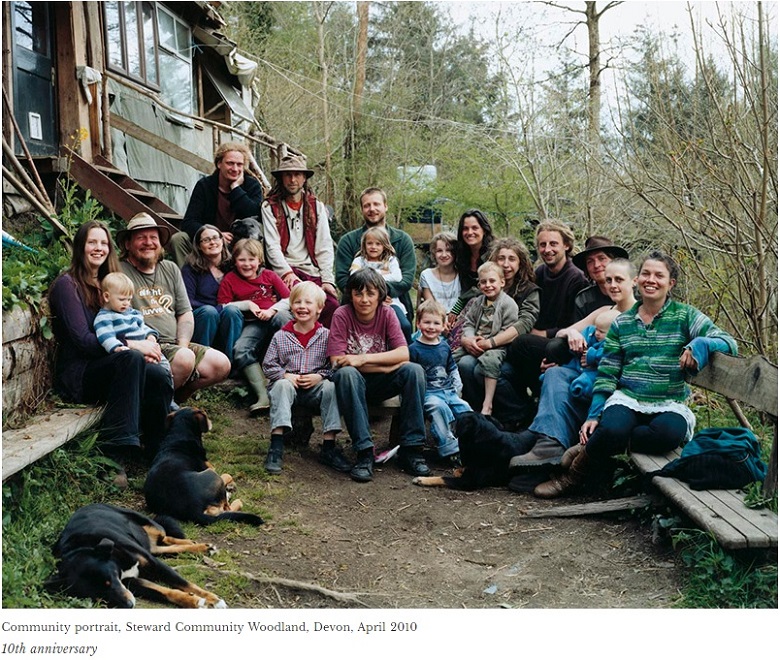
Woodland Management, Food and Medicine
We are managing the land using the principles of permaculture, forest
gardening and continuous-cover forestry. Our management of the woodland
is for fuel, timber and the creation and protection of wildlife
habitats. Our success in this area was recently affirmed by an officer
of the Devon Wildlife Trust, who stated: ‘Overall we consider that your
management is having a very positive impact on your local biodiversity.’
Providing food and medicine for ourselves and volunteers is a vital and
intrinsic part of demonstrating low impact living. We do so by: growing
and cultivating; gathering and preserving wild foods, herbs and
medicines; animal husbandry (chickens, goats, sheep); swapping excess
produce and seeds with other local growers; and hunting squirrels,
rabbits and deer, thus controlling local pests and providing ourselves
with meat with no food miles.
Community Outreach and Voluntary Work; Volunteers and Visitors
Residents have a significant positive effect on the local community
through the many activities and groups we are involved with in
Moretonhampstead and its environs, such as the Moretonhampstead
Development Trust, the primary school and community projects and events.
We are also a WWOOF host (World Wide Opportunities on Organic Farms) and
accommodate volunteers throughout the year from all over the world. It’s
a mutually beneficial relationship – we get lots of jobs done benefiting
from the fresh energy of volunteers, who in return learn new skills and
experience community life and the beautiful woodland.
We also have many visitors throughout the year on our Open Days, on
educational trips and at other events.
Education of Children
Four of the children go to local schools, while three children choose to
be home-educated. The teenagers are now following their own paths,
with one about to go to college. The education that they receive by
living here and being a part of the community is a vital part of their
lives. Given the prospects of climate change and other environmental
challenges, we believe that living here with the children fully
integrated is the best way to teach them important skills in sustainable
living, being in harmony with nature, and caretaking the land and its
creatures.
We encourage the children to have active involvement in every aspect of
communal living as part of their education. This includes generating
their own power, keeping themselves clean and warm, growing and cooking
food, sustainably harvesting wild food and medicine, providing shelter,
managing the woodland, dealing with waste, and relearning lost skills of
communication and resolving conflict in a peaceful way.
The children are also able to pass on their skills and knowledge to
other children and adults through play etc., as well as taking part in
running workshops and courses, and giving tours, talks and
demonstrations. Visitors are frequently amazed when the children
demonstrate their skills in firewood chopping, fire-making, cooking and
music, and by their contributions to social interaction. The children
frequently bring their friends back to the woods to play and for
sleepovers, increasing the connections with the wider community and
giving those children the opportunity to experience low impact living
and community life.
The Future
We are currently applying for permanent planning permission. As part of
this, we are shifting the Settlement Area within the woodland a little
downhill so that most of our homes are below the waterline, allowing the
water to flow without being pumped and also to reduce the uphill trek
needed to get to them. We are also moving away from canvas-based
structures to using shingles, turf roofs and timber cladding, while
improving insulation (e.g. by using straw) and making more use of
thermal mass (in particular cob) to maintain heat. Furthermore, we are
applying for a turf-roofed roundhouse interpretation centre, a
polytunnel and a disabled-accessible compost toilet.
We look forward to a future in which we continue to deepen our
connection with the land and its wildlife, with each other and with the
wider community.
Daniel Thompson-Mills, February 2015
Planning update February 2015 to June 2019
In October 2015 Steward Community Woodland made an application to the
Dartmoor National Park Authority (DNPA) for permanent planning
permission. This was refused. After raising £38,000 through crowdfunding
to cover legal and other costs, Steward Community Woodland appealed to
the planning inspectorate. A public inquiry was held over five days in
April and May 2016, and on 10 August the planning inspector dismissed
the appeal, leaving the community with 12 months to dismantle and remove
their homes.
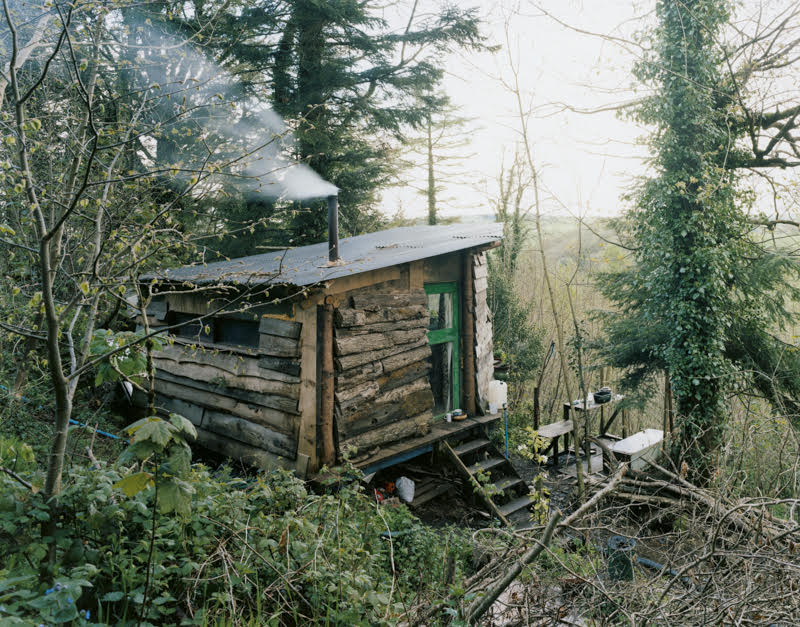
Jamie’s, Steward Community Woodland, Devon, April 2014
Roundwood timber-frame cabin with waney board and slab wood cladding and
tin roof. Constructed by Kate 2011, replacing Peter’s house.
Casting aside the ‘benefits that arise from the development’, the
inspector argued that the existing and proposed development harms, or
would harm, ‘the character and appearance of Dartmoor National Park’ and
‘the purposes of the National Park designation’.
One of his main arguments was the threat posed to the ‘canopy cover’
from continued human habitation, despite accepting that thus far – 16
years – there had been ‘minimal’ visual impact. He also stated that, in
his view, the dwellings were ‘not of high quality design’ . But no
matter what one’s opinion on the highly subjective question of design,
it is hard to consider the dwellings harmful to the character and
appearance of the park when compared to the adjoining sewage works,
rifle range and A382.
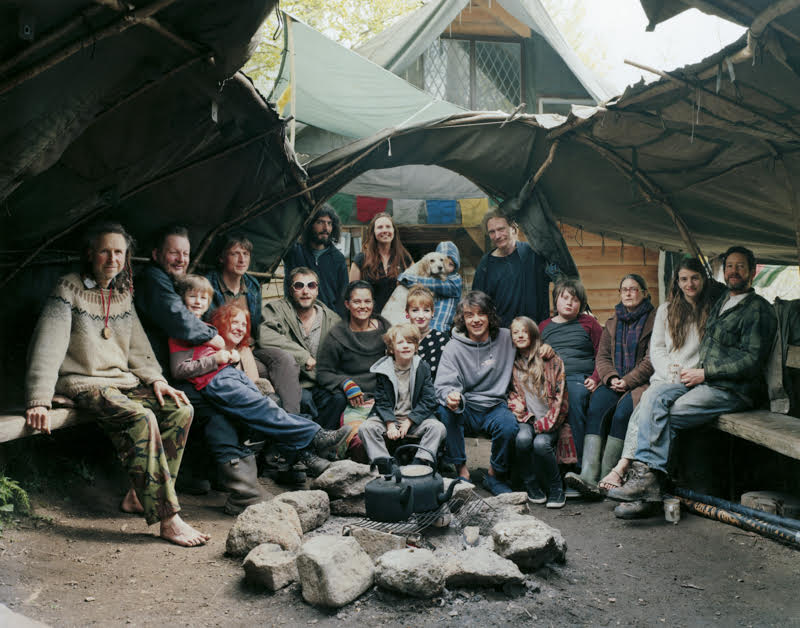
Community portrait, Steward
Community Woodland, Devon, May
2015
Without Chris, Owen and Aaron. 15th anniversary
Although acknowledging the loss to the residents and cultural loss to
the local area resulting from the refusal, he balanced this against the
‘opportunities for others to enjoy and understand the special qualities
of the park’. The removal of the community and the subsequent loss of
educational courses, voluntary opportunities, events and tours they
provide would in fact have the opposite effect.
Crucially, the inspector decided to classify the dwellings as ‘cabins’:
‘The Oxford English Dictionary defines a cabin as being a small wooden
shelter or house. Both of the structures that I went inside are, in my
view, cabins. I have no doubt that other structures existing on the
site, as well as some of those proposed, are also cabins. It follows
that these structures do not fall with [sic.] scope of Policy DMD30 as
set out in the supporting text to that policy and therefore do not
accord with it.’
For some reason cabins (which can be very low impact) are specifically
excluded under the park’s low impact policy DMD30. Remarkably the policy
gives no guidance or definition of a cabin which is even more remarkable
given that there is no ‘statutory’ legal definition. Instead of
reverting back to the planning inspectorate for advice the planning
inspector took it upon himself to create a shoddily researched and
thoroughly skewed definition.
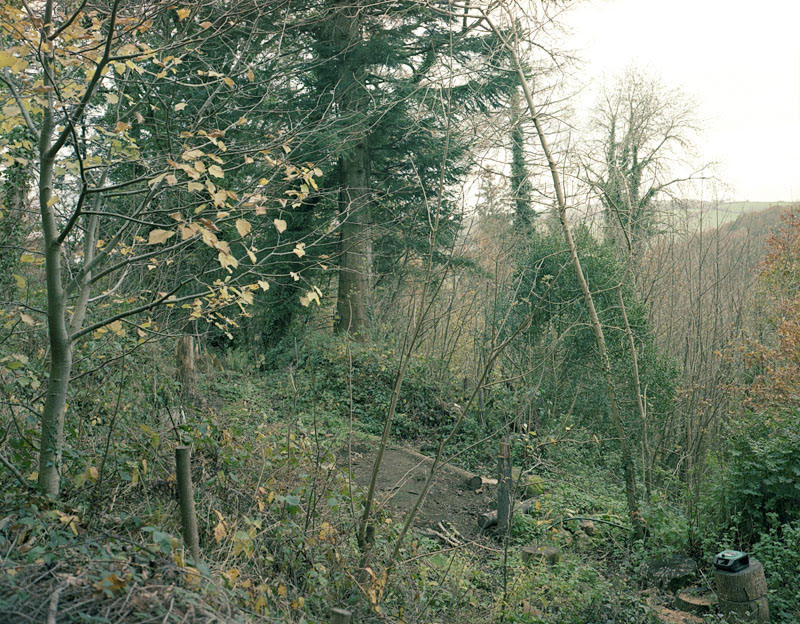
Site of Lorna’s house, Steward Community Woodland, Devon, September
2017.
Enforcement Notice compliance period. Constructed by Kate 2011,
replacing Peter’s house. Subsequently, Jamie’s, Sharif and Ferns, and
Lorna’s
For his interpretation he partially used the Oxford Dictionary of
English definition a small wooden shelter or house , omitting the second
half of the definition in a wild and isolated location, which is hardly
the case with Steward Community Woodland. He also mistakenly attributed
the definition to the Oxford English Dictionary whose actual
definitions: 1. A temporary shelter of slight materials; a tent, booth,
temporary hut; 2. A permanent human habitation of a rude construction,
can be used to argue either way as to whether the dwellings are cabins.
Quite ironically the two structure types that DMD30 suggests might be
low impact, yurts and benders, would have to be classified as cabins
using these definitions.
But perhaps it would have been more appropriate to use the Oxford
Dictionary of Architecture ’s definition, a small, single-roomed
primitive dwelling. With this definition only one dwelling (which is
single roomed) could be classified a cabin, allowing the remaining nine
to be considered under the park’s low impact policy. The policy allows
for low impact developments in the open countryside and was specifically
introduced in response to Steward Community Woodland.
Dr Tom Grieves, chairman of the Dartmoor Society, writing in response to
the decision in the Western Morning News (18/8/16) suggested: ‘A
national park that cannot accommodate and celebrate the community
woodland needs reform. The residents’ lifestyle is unusual, but is
refreshing and stimulating. They have demonstrated a remarkable
commitment, through winter rains and storms, to a way of life very
different from most of us. They are deeply integrated with the very
supportive local community. Their gentle impact on the land, philosophy
and brave experiment should be celebrated, and presented as a leading
example of how some of us might live in the future, supported by an
innovative and flexible park authority, which, since July 2013, has even
introduced a policy for “low-impact residential development in the open
countryside” [...] The dismissal of their appeal is denial of what
Dartmoor could and should be, at a time of environmental concern.’
After taking legal advice Steward Community
Woodland applied for a Judicial Review to challenge the planning
inspectors decision on the grounds that he had wrongly interpreted the
DNPA’s planning policies. The application was rejected at a High Court
hearing in Bristol on 2nd December 2016.
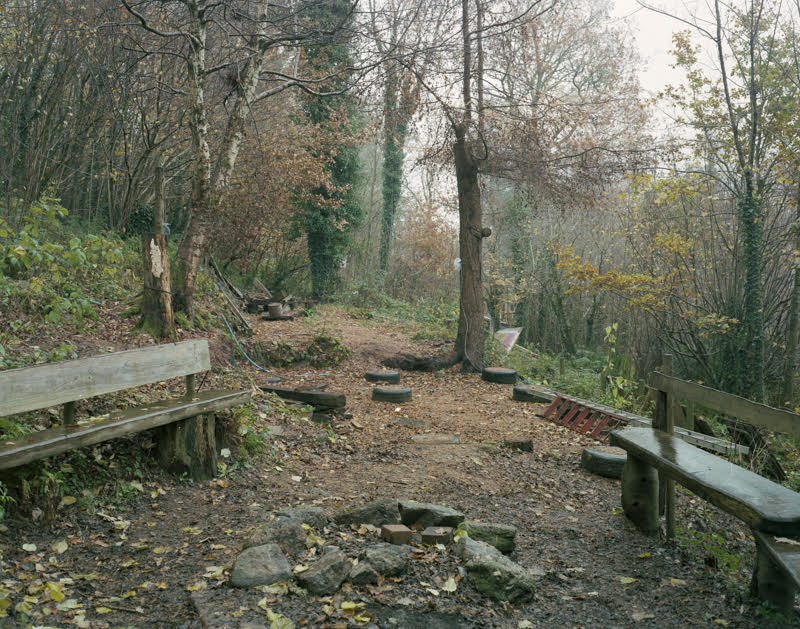
Fire pit, looking towards the sight of ‘The Longhouse’, Steward
Community Woodland, Devon, November
2018.
Court Injunction compliance period
Although this ruled out any further possibility of challenging the
inspectors decision there were two positive outcomes. First the
Enforcement Notice compliance dates were moved from 11th August 2017 to
2nd December 2017 and second the community now felt it had the clarity
of closure it needed to move forward.
In a message to supporters in January 2017 the community stated that
‘Our task is now to negotiate with the National Park and reconfigure the
project in such a way that it can fit with Policy DMD30 (the Park's
policy on low impact development) with the intention of submitting a
fresh planning application. Our next step is to write to the park with
'Pre-Application Inquiries', asking them to set out clearly what type of
structures they consider are acceptable under the policy etc.’
Three months later, in April 2017, community members marched with around
150 supporters to the DNPA’s office in Bovey Tracey to present a 5,500
signature petition calling on the park to reconsider its decision and
reach a compromise. Accepting the petition a DNPA representative
responded positively suggesting some form of discussion, but nothing was
forthcoming.
That autumn, with the still DNPA unable to give any practical guidance
as to what structures are allowable under its low impact DMD30 policy,
the community submitted for ‘Pre-Application Inquiry’ its new planning
proposal designed to fit in with DMD30 and to address the planning
inspectors concerns. The application was rejected on the grounds that it
was too similar to the previous one that had been refused.
That December the Enforcement Notice compliance period ended which meant
the DNPA could seek an injunction to enforce the notices. Once served
any non-compliance would become a criminal offence.
By January 2018 two households had found accommodation and were
dismantling their homes. The six other households, as yet unable to find
any affordable accommodation, had little choice but to remain on site.
Weekly work days were now taking place to dismantle homes and communal
infrastructure.
In late August with two household remaining on site the DNPA commenced
injunction proceedings and a court hearing date was set for 9th October
2018. On receiving the draft injunction the remaining households
informed the DNPA that they would contest the injunction on numerous
grounds, the main one being that it listed and held their children
accountable. This effectively held them accountable for decisions taken
by their parents.
At the hearing the judge amended the injunction to ensure the children
would not be accountable. The park offered not to apply for costs and to
also extend the compliance period from 90 to 180 days to 7th April 2019.
In response the community withdrew all other objections. The injunction
was served and by the agreed compliance date the remaining households
had left the woodlands and all non-agricultural structures had been
removed.
All members of the community found accommodation nearby. Most are now
living in the neighbouring village of Moretonhampstead, a ten minute
walk away. They are all on site regularly. Steward Community Woodland
have now begun a visioning process for the future of the community and
woodland.
David Spero, June 2019
www.davidspero.co.uk
David Spero: 'Settlements' was at
Kestle Barton
20.7.19-8.9.19
http://www.artcornwall.org/exhibitions/David_Spero/David_Spero_Settlements2.htm
24.8.19
|








